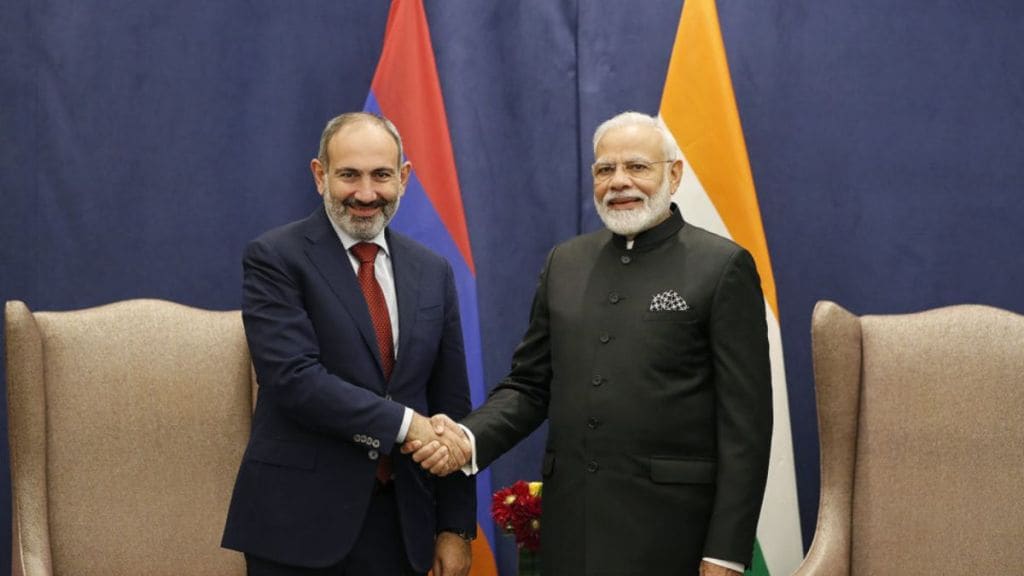By Dr Pravesh Kumar Gupta
India and Armenia have centuries-old historical ties and are strategically important to one another in modern times. However, despite the convergence of interests, bilateral ties remain underdeveloped. S. Jaishankar, India’s External Affairs Minister visited Armenia in October 2021, the first visit by an Indian Foreign Minister since the two countries established diplomatic relations in 1992. In order to elevate the level of bilateral cooperation, there are some areas that necessitate immediate attention. Agriculture, pharmaceuticals, and information technology are three areas where New Delhi and Yerevan could expand their partnership. Due to the absence of direct land connectivity between the two nations, bilateral trade is below its potential.
Some notable initiatives have been launched to address the issues associated with the low amount of trade. However, there has been a delay in implementing such measures, which has impeded the growth of bilateral ties. A free trade agreement (FTA) between New Delhi and the Russia-led Eurasian Economic Union (EAEU) is currently being negotiated. Since Armenia is an EAEU member, the conclusion of this FTA would contribute to boosting bilateral trade. Also, India and Armenia are members of the International North-South Transport Corridor (INSTC). Yet, closer cooperation between these two countries is required in order to promote INSTC as a means of transportation between the two countries. Following the Ukrainian conflict, the changing geopolitical landscape presented an opportunity to revitalise the INSTC. Since Russia is pushing for it, New Delhi and Yerevan should also proactively support it. However, to stimulate the areas mentioned above of bilateral cooperation, it is critical to maintain consistency in bilateral engagement at the highest level.
The Strategic Dimension of India-Armenia Relations
The changing regional geopolitics of the South Caucasus has put India-Armenia relations to the test. As Azerbaijan’s all-weather ally, Turkey is attempting to position itself as a regional leader and wants to expand its outreach to the Central Asian region as well. Azerbaijan serves as a launching pad for Turkey’s expansion into Central Asia. Countering Turkey’s and its close ally Pakistan’s disruptive objectives is a key convergence of interests between India and Armenia.
These regional geopolitical changes have also prompted India and Armenia to strengthen their relationship. Cooperation in connectivity, security, and defence has emerged as an important component of their bilateral ties. Cooperation in the defence sector is a crucial area with a lot of potential. Armed conflict along Armenia’s border with Azerbaijan has pushed the country to sign a defence export deal with India. Under a newly inked export agreement, New Delhi would send military weapons such as missiles, rockets, and ammunition to Armenia.
Moreover, indigenous Pinaka multi-barrel rocket launchers, anti-tank rockets, and ammunition will be exported for the first time from India to Armenia. This contract is estimated to be worth more than Rs. 2,000 crores. Earlier in May 2020, Delhi and Yerevan agreed to exchange four SWATHI weapon locating radars, developed by the DRDO and capable of pinpointing enemy assets like mortars, shells, and rockets at a distance of 50 km for USD 40 million. This comes as border tensions between Armenia and Azerbaijan keep on escalating frequently. The latter maintains strong diplomatic and military ties with Pakistan and Turkey. Turkey, Pakistan, and Azerbaijan signed a Trilateral Ministers Agreement in 2017 to promote defence cooperation and strengthen bilateral military assistance arrangements. As a result, the recent defence export agreement between India and Armenia is strategic.
Indian policymakers intend to extend the International North-South Transport Corridor through Armenia to connect the Chabahar port in southeast Iran and the Indian Ocean to Eurasia and Finland (INSTC). Once fully operational, Chabahar will become one of the region’s most strategic and busy ports. The INSTC, which many see as a counter to China’s Belt and Road Initiative (BRI), was conceived in 2000 by India, Iran, and Russia. This will also allow Indian and other South East Asian exporters to reach Iran and other Central Asian countries while avoiding Pakistan and Afghanistan, where security concerns continue to be a major issue.
In conclusion, it would be correct to state that India and Armenia share common interests in a wide range of areas and that there is great potential for security cooperation. And the defence agreement concluded by the two countries may open the door for increased security cooperation. Armenia also provides a viable location for India’s outreach to the South Caucasus, where Turkey aspires to be the regional leader. In addition to trade, economy, and connectivity, there is potential for trilateral engagement between India, Armenia, and Russia in the security sector. All of this, however, necessitates India’s active participation and Yerevan’s reciprocating approach.
Author is Senior Research Associate (Central Asia), Vivekananda International Foundation.
Disclaimer: Views expressed are personal and do not reflect the official position or policy of Financial Express Online. Reproducing this content without permission is prohibited.

